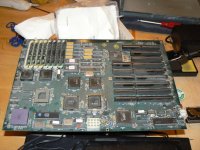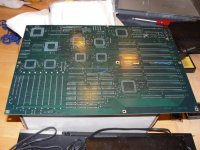wesleyfurr
Veteran Member
I debated where to post this, but figured this would be a better section for this machine than the Tandy section.
I have a Tandy 4000 (the big 386-16) that I picked up on ebay a number of years ago. It was listed as good, but wouldn't post. Only thing I could find wrong with it at the time was a browned capacitor. I still wanted it for my collection, so the seller gave me a partial refund and I kept it. Time went by and I learned about dead Tantalum capacitors keeping things from working. I snipped one of the leads of the bad looking capacitor and it fired up and beeped!
Finally tonight got around to replacing the bad capacitor and then hooked it up to a keyboard and monitor for further testing. First power up it did not post. Power cycled it and then it came up. At some point I power cycled it again and it took a few cycles to get it to come back to life. Looks like something may be goofy...any thoughts what might cause it to sometimes not POST sometimes?
I removed the CMOS battery a while back to make sure it didn't leak and ruin the machine as happened to my Tandy 3000 some years back. :-( So...of course it is lacking a good config. Made a boot disk and copied the setup program to it...boot from floppy and configured everything. I set it to drive type 39, which matches the 6 heads/820 cylinders/17 sectors of the ST-251 that is installed. It fires up, complains about "invalid configuration information - please run setup program", then says "hard disk failure" press F1 to retry boot. It is counting up 640k base and 1024k extended...not sure what size chips are installed, but they are 8x 30-pin SIMMS...guessing 256k each, in which case that would be the correct default. Any idea on a Tandy 4000 if it will read 1024k when there is really more installed? And what video type should I be using for a VGA card - 80 column color, or EGA? Just wondering what it is complaining about...
I'm ashamed to have to even ask this question, but it's been too long...if the ST-251 drive is dead, would that cause the "hard disk failure" message? I'm assuming non-matching disk type setting would not cause that message? How reliable are those old Seagate MFM drives these days? I was under the impression that they held up pretty well...but I may have gotten the wrong impression! The spin-up sounds seem a little off, but it's been years since I fired one up...
Any thoughts appreciated...
Thanks,
Wesley
I have a Tandy 4000 (the big 386-16) that I picked up on ebay a number of years ago. It was listed as good, but wouldn't post. Only thing I could find wrong with it at the time was a browned capacitor. I still wanted it for my collection, so the seller gave me a partial refund and I kept it. Time went by and I learned about dead Tantalum capacitors keeping things from working. I snipped one of the leads of the bad looking capacitor and it fired up and beeped!
Finally tonight got around to replacing the bad capacitor and then hooked it up to a keyboard and monitor for further testing. First power up it did not post. Power cycled it and then it came up. At some point I power cycled it again and it took a few cycles to get it to come back to life. Looks like something may be goofy...any thoughts what might cause it to sometimes not POST sometimes?
I removed the CMOS battery a while back to make sure it didn't leak and ruin the machine as happened to my Tandy 3000 some years back. :-( So...of course it is lacking a good config. Made a boot disk and copied the setup program to it...boot from floppy and configured everything. I set it to drive type 39, which matches the 6 heads/820 cylinders/17 sectors of the ST-251 that is installed. It fires up, complains about "invalid configuration information - please run setup program", then says "hard disk failure" press F1 to retry boot. It is counting up 640k base and 1024k extended...not sure what size chips are installed, but they are 8x 30-pin SIMMS...guessing 256k each, in which case that would be the correct default. Any idea on a Tandy 4000 if it will read 1024k when there is really more installed? And what video type should I be using for a VGA card - 80 column color, or EGA? Just wondering what it is complaining about...
I'm ashamed to have to even ask this question, but it's been too long...if the ST-251 drive is dead, would that cause the "hard disk failure" message? I'm assuming non-matching disk type setting would not cause that message? How reliable are those old Seagate MFM drives these days? I was under the impression that they held up pretty well...but I may have gotten the wrong impression! The spin-up sounds seem a little off, but it's been years since I fired one up...
Any thoughts appreciated...
Thanks,
Wesley


